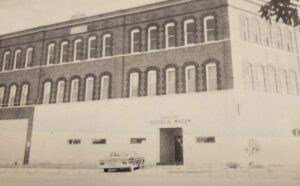Rachel Whitney, Curator,
Sapulpa Historical Museum
In the early hours of December 29, 1917, a “mystery blaze” lit up the downtown scene.
“Sixty-five thousand dollars went up in smoke and flame early this morning and full as much more was imperiled when the Max Meyer Clothing store and Mize Drug Store, located in the Wills Building, corner of Water and Dewey, were reduced to piles of ashes and debris.”
Firefighters raced to the scene. On this December night, it was cold and dark. At the scene, it was a huge contrast to the night, as the building was illuminated by fire.
“Also, one of the finest pieces of fire-fighting this, or any other city has ever witnessed, occurred. The alarm was turned in at 2:20 o’clock in the heart of the coldest night of the year-two below zero. The Central Station responded first. When they got on the scene they found the rear of the second story all ablaze, dense volumes of smoke issuing and the roof about to fall in.”
Hurrying to the building, the firefighters worked through the neighboring building, the Berryhill Building. “They quickly ran hose into the Berryhill Building adjoining and played from the third story. Three of them leaped to the roof of the Wills and fought from this point. The fire had evidently been burning for some time as the roof soon caved in and the entire upper stories over the Max Meyer Clothing Store and the Mize Drug Store were aflame.”
The weather also played a key role in the extinguishing of the fire. “A stiff north wind was blowing and the water turned to ice almost as soon as it struck the burning material. In two minutes, every fireman was encased in a coat of ice.”
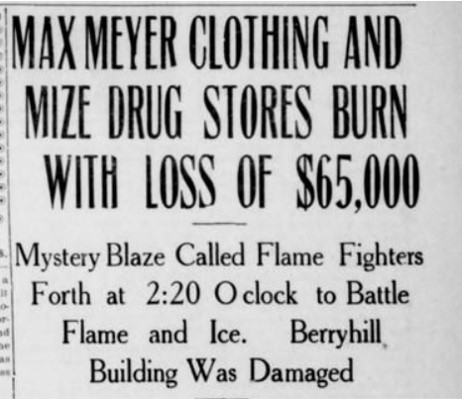
Another factor took place, the neighboring buildings and their safety. “The Berryhill Building caught and seemed doomed. Presently the roof of the Wills Building collapsed. Every window on the third story was ablaze at one time. Fortunately, an interior fire screen assisted the men, else this would have been a quarter-million-dollar fire. Just before they left the roof, two explosions in the rear of the drug store occurred.”
If the fire, roof-collapse, the freeze of the night, and the neighboring building catching on fire wasn’t enough, another worry crossed the firefighters and Fire Chief’s mind. Chief Osborn witnessed fireman Wood Fuller “was overcome by fumes while in that section [of the drug store] and the fumes, probably chemical, were inhaled. He was temporarily knocked out, but rallied and kept in the battle. This morning he was a sick man as the fumes entered his lungs.”
Another firefighter struggled at the scene. “Fireman Ben Doyle was temporarily overcome by smoke at one time, but he also stuck to his post.”
Firefighters from Station No. 2 arrived to aid the first crew. They created five lines of hose, “pouring streams downstairs and from the east side. Here again was good work shown, drugs and chemicals on one side and hats and clothing on the other made a bad combination on a night when water froze as it lit.”
The mystery of the fire was how it started. “The origin of the fire is a matter of much speculation. The upper floor of the Wills Building, where the firemen believe the blaze started, was unoccupied. It had been used as a lodging house but had not been occupied recently. It was cut into seven skeleton rooms, with flimsy partitions. No stove was there. When the firemen got on the scene the roof was about to cave in at the rear.” Even the clothing stock inventory was not near the possible starting point, as it was near the front over the store, not the rear.
Damages were caused and the estimated value of the damage were presumed the following morning. “The Meyer Store stock was valued presumably at $40,000; the loss may reach half of this, although the salvage on certain goods will be considerable. J.N. Mize had only been in the present location just a few months. His loss is apparently larger in proportion, although much of the bottle goods will be redeemed.”
The Wills Building was a complete loss. “At present prices, $25,000 ($580,000 today) would be a fair estimate. Meyer’s loss may be put at $20,000 ($470,000 today), and Mize’s at the same. The loss on the Berryhill Building is approximately $1,000 ($24,000 today) due to broken glass of expensive kind and slight water damage.*”
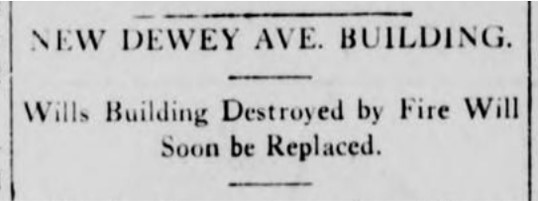
Both Meyer and Mize would receive $18,000 for their insurance claim. The Wills Building would also be replaced with a new building at its location. “The building on the corner of Dewey Avenue and Water Street, which was destroyed by fire the latter part of December, will soon be replaced by a modern two-story building, costing $8,000 or $9,000 (approximately $200,000 today).”
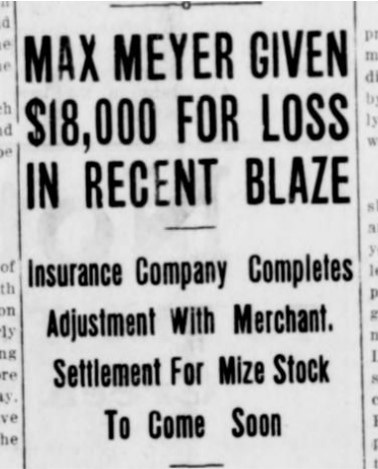
Mize would move to another building on East Dewey. “The Mize Drug Store will open its new quarters tomorrow in the building on East Dewey recently vacated by the Rose Bargain House. Few of the soda fountain fixtures were injured in the recent fire the store suffered, and those have been replaced with new ones. All the old furnishes have been thoroughly renovated and the new store will rival the old for beauty and completeness of stock.”

Meyer would reopen on North Main. He was able to sell some goods that were damaged by the water hoses. “Fire Notice: having been fortunate enough in saving something like $30,000 ($700,000 today) worth of goods, that were just water-soaked, and some was dried in the Old Kinley Building.”
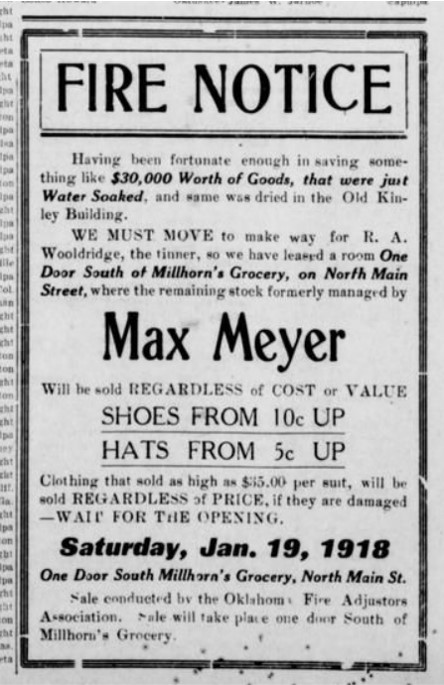
Meyer also wanted to thank the fire firefighters for their hard, dedicated work on that cold night. “As a token of his appreciation for the work done by the Sapulpa Fire Department when his clothing store burned recently, Max Meyer presented the department with a check for $100. ($2,340 today).”

(Sapulpa Herald, December 29, 1917, January 2, 1918, January 12, 1918, January 14, 1918; Creek County Republican, January 4, 1918, January 18, 1918, February 22, 1918, May 10, 1918)




